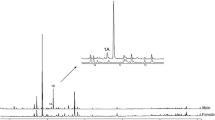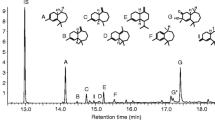Abstract
5-Methyl-4-octanol is the major aggregation pheromone of the palmetto weevil,Rhynchophorus cruentatus (F.). The pheromone (cruentol) was identified by coupled gas chromatographic-electroantennographic (GC-EAD) analysis of male-produced volatiles, coupled GC-mass spectrometry (MS) in electron impact and chemical ionization mode, and coupled GC-high resolution MS. In laboratory and field assays, a diastereomeric mixture of synthetic cruentol greatly enhanced attraction of weevils to cabbage palmetto,Sabal palmetto (Walter), stem tissue, indicating that cruentol and host volatiles are synergistically attractive. An attractive lure in combination with efficient traps should facilitate development of semiochemical-based management forR. cruentatus.
Similar content being viewed by others
References
Arn, H., Stadler, E., andRauscher, S. 1975. The electroantennographic detector—a selective and sensitive tool in the gas chromatographic analysis of insect pheromones.Z. Naturforsch 30c:722–725.
Blight M.M., andWadhams, L.J. 1987. Male-produced aggregation pheromone in pea and bean weevil,Sitona lineatus (L.).J. Chem. Ecol. 13:733–739.
Blight, M.M., Pickett, J.A., Smith, M.C., andWadhams, L.J. 1984. An aggregation pheromone ofSitona lineatus. Identification and initial field studies.Naturwissenschaften 71:480–481.
Booth, D.C., Phillips, T.W., Claesson, A., Silverstein, R.M., Lanier, G.N., andWest, J.R. 1983. Aggregation pheromone components of two species ofPissodes weevils (Coleoptera: Curculionidae): Isolation, identification, and field activity.J. Chem. Ecol. 9:1–12.
Chittenden, F.H. 1902. The palm and palmetto weevils.USDA Entomol. Bull. 38:23–28.
Giblin-Davis, R.M., andHoward, F.W. 1988. Notes on the palmetto weevil,Rhynchophorus cruentatas (Coleoptera: Curculionidae).Proc. Fla. State Hortic. Soc. 101:101–107.
Giblin-Davis, R.M., andHoward, F.W. 1989. Vulnerability of stressed palms to attack byRhynchophorus cruentatus (Coleoptera: Curculionidae) and insecticidal control of the pest.J. Econ. Entomol. 82:1185–1190.
Giblin-Davis, R.M., Gerber, K., andGriffith, R. 1989. Laboratory rearing ofRhynchophorus cruentatus andR. palmarum (Coleoptera: Curculionidae).Fla. Entomol. 72:480–488.
Giblin-Davis, R.M., Weissling, T.J., Oehlschlager, A.C., andGonzalez, L.M. 1994. Field response ofRhynchophorus cruentatus (F.) (Coleoptera: Curulionidae) to its aggregation pheromone and fermenting plant volatiles.Fla. Entomol. In press.
Gries, G., Gries, R., Perez, A.L., Oehlschlager, A.C., Gonzales, L.M., Pierce, H.D., Jr., Kouda, M., Zebeyou, M., andNanou, N. 1993. Aggregation pheromone of the African palm weevil,Rhynchophorus phoenicis F.Naturwissenschaften 80:90–91.
Hallett, R.H., Gries, G., Gries, R., Borden, J.H., Czyzewska, E., Oehlschlager, A.C., Pierce, H.D., Jr., Angerilli, N.P.D., and Ranf, A. 1993. Aggregation pheromone of two Asian palm weevils,Rhynchophorus ferrugineus (Oliv.) andR. vulneratus (Panz.).Naturwissenschaften 80:328–331.
Oehlschlager, A.C., Pierce, A.M., Pierce, H.D., Jr., and Borden, J.H. 1988. Chemical communication in cucujid grain beetles.J. Chem. Ecol. 14:2071–2098.
Oehlschlager, A.C., Pierce, H.D., Jr., Morgan, B., Wimalaratne, P.D.C., Slessor, K.N., King, G.G.S., Gries, G., Gries, R., Borden, J.H., Jiron, L.F., Chinchilla, C.M., and Mexzan, R.G. 1992. Chirality and field activity of Rhynchophorol, the aggregation pheromone of the American palm weevil.Naturwissenschaften 79:134–135.
Oehlschlager, A.C., Perez, A.L., Pierce, H.D., Jr., Gonzalez, L.M., Gries, G., and Gries, R. 1994. Aggregation pheromone of the Asian palm weevilRhynchophorus bilineatus. Naturwissenschaften submitted.
Perez, A.L., Gonzalez, L.M., Pierce, H.D., Jr., Oehlschlager, A.C., Gries, G., Gries, R., Giblin-Davis, R.M., Peña, J.E., Duncan, R.E., and Chinchilla, C.M. 1994. Aggregation pheromone of the sugarcane weevil,Metamasius hemipterus sericeus (Oliver).Naturwissenschaften Accepted.
Phillips, T.W., West, J.R., Foltz, J.L., Silverstein, R.M., andLanier, G.N. 1984. Aggregation pheromone of the deodar weevil,Pissodes nemorensis (Coleoptera: Curculionidae): Isolation and activity of grandisol and grandisal.J. Chem. Ecol. 10:1417–1423.
Phillips, J.K., Walgenbach, C.A., Klein, J.A., Burkholder, W.E., Schmuff, N.R., andFales, H.M. (1985). (R*,S*)-5-hydroxy-4-methyl-3-heptanone: A male-produced aggregation pheromone ofSitophilus oryzae (L.) andS. zeamais Motch.J. Chem. Ecol. 11:1263–1274.
Phillips, T.W., Teale, S.A., andLanier, G.N. 1987. Biosystematics ofPissodes Germar (Coleoptera: Curculionidae): Seasonality, morphology, and synonymy ofP. approximatus Hopkins andP. nemorensis Germar.Can. Entomol. 119:465–480.
Pinazzi, C.P., Rabadeux, J.C., andPleurdeau, A. 1976. Investigation with model molecules of the reactivity of polychloroformates.Bull. Soc. Chim. Fr. 4:501–503.
Pinazzi, C.P., Rabadeux, J.C., andPleurdeau, A. 1977. Polymères à propriètès pharmaceutiques potentielles. III. Etude sur molecules modèles.J. Polymer Sci. 15:2909–2917.
Rochat, D., Malosse, C., Lettere, M. Ducrot, P.H., Zagatti, P., Renou, M., andDescoins, C. 1991. Male-produced aggregation pheromone of the American palm weevil,Rhynchophorus palmarum (L.) (Coleoptera: Curculionidae): Collection, identification, electrophysiological activity, and laboratory bioassay.J. Chem. Ecol. 17:2127–2140.
SAS Institute. 1985. SAS User's Guide: Statistics, 5th ed. SAS Institute, Cary, NC.
Schmuff, N.R., Phillips, J.K., Burkholder, W.E., Fales, H.M., Chen, C.W., Roller, P.P., andMa, M. 1984. The chemical identification of the rice weevil and maize weevil aggregation pheromone.Tetrahedron Lett. 25:1533–1534.
Wattanapongsiri, A. 1966. A Revision of the GeneraRhynchophorus andDynamis (Coleoptera: Curculionidae), vol. 1. Department of Agricultural Science Bulletin, Bangkok, 328 pp.
Weissling, T.J., Giblin-Davis, R.M., Scheffrahn R.H., andMendoza, N.M. 1992. Trap for capturing and retainingRhynchophorus cruentatus (Coleoptera: Curculionidae) adults usingSabal palmetto as bait.Fla. Entomol. 75:212–221.
Weissling, T.J., Giblin-Davis, R.M., andScheffrahn, R.H. 1993. Laboratory and field evidence for male-produced aggregation pheromone inRhynchophorus cruentatus (F.) (Coleoptera: Curculionidae).J. Chem. Ecol. 19:1195–1203.
Woodruff, R.E. 1967. A giant palm weevil,Rhynchophorus cruentatus (Fab.) in Florida (Coleoptera: Curculionidae). Florida Department of Agriculture, Division of Plant Industry, Entomology Circular No. 63.
Author information
Authors and Affiliations
Rights and permissions
About this article
Cite this article
Weissling, T.J., Giblin-Davis, R.M., Gries, G. et al. Aggregation pheromone of palmetto weevil,Rhynchophorus cruentatus (F.) (Coleoptera: Curculionidae). J Chem Ecol 20, 505–515 (1994). https://doi.org/10.1007/BF02059593
Received:
Accepted:
Issue Date:
DOI: https://doi.org/10.1007/BF02059593




